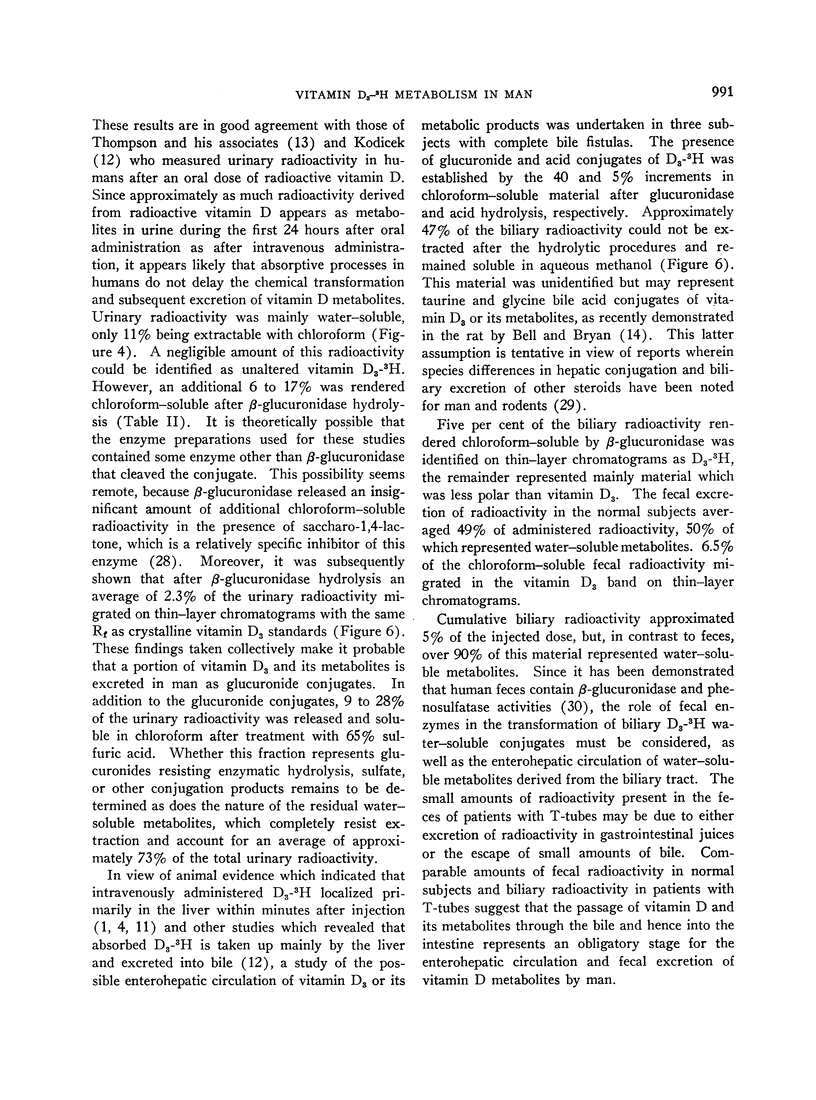Abstract
Vitamin D3-3H has been administered intravenously to seven normal subjects, three patients with biliary fistulas, and four patients with cirrhosis. Plasma D3-3H half-times normally ranged from 20 to 30 hours. in vivo evidence that a metabolic transformation of vitamin D occurs was obtained, and a polar biologically active vitamin D metabolite was isolated from plasma.
Urinary radioactivity averaged 2.4% of the administered dose for the 48-hour period after infusion, and all the excreted radioactivity represented chemically altered metabolites of vitamin D. The metabolites in urine were mainly water-soluble, with 26% in conjugated form.
From 3 to 6% of the injected radioactivity was excreted in the bile of subjects with T-tube drainage and 5% in the feces of patients having no T-tube. The pattern of fecal and biliary radioactivity suggested that the passage of vitamin D and its metabolites from bile into the intestine represents an essential stage for the fecal excretion of vitamin D metabolites in man.
Abnormally slow plasma disappearance of vitamin D3-3H in patients with cirrhosis was associated with a significant decrease in the quantity and rate of glucuronide metabolite excretion in the urine.
Full text
PDF









Selected References
These references are in PubMed. This may not be the complete list of references from this article.
- ATKINSON M., NORDIN B. E., SHERLOCK S. Malabsorption and bone disease in prolonged obstructive jaundice. Q J Med. 1956 Jul;25(99):299–312. [PubMed] [Google Scholar]
- BLIGH E. G., DYER W. J. A rapid method of total lipid extraction and purification. Can J Biochem Physiol. 1959 Aug;37(8):911–917. doi: 10.1139/o59-099. [DOI] [PubMed] [Google Scholar]
- BRADLOW H. L., FRAZELL E. L., GALLAGHER T. F., HELLMAN L. Tracer studies of the absorption and fate of steroid hormones in man. J Clin Invest. 1956 Sep;35(9):1033–1044. doi: 10.1172/JCI103349. [DOI] [PMC free article] [PubMed] [Google Scholar]
- Callow R. K., Kodicek E., Thompson G. A. Metabolism of tritiated vitamin D. Proc R Soc Lond B Biol Sci. 1966 Feb 15;164(994):1–20. doi: 10.1098/rspb.1966.0010. [DOI] [PubMed] [Google Scholar]
- Chen P. S., Jr, Lane K. Serum protein binding of vitamin D3. Arch Biochem Biophys. 1965 Oct;112(1):70–75. doi: 10.1016/0003-9861(65)90011-1. [DOI] [PubMed] [Google Scholar]
- KELLY R. G., PEETS E. A., GORDON S., BUYSKE D. A. Determination of C-14 and H3 in biological samples by Schoeniger combustion and liquid scintillation techniques. Anal Biochem. 1961 Jun;2:267–273. doi: 10.1016/s0003-2697(61)80010-9. [DOI] [PubMed] [Google Scholar]
- LEVVY G. A. The preparation and properties of beta-glucuronidase. IV. Inhibition by sugar acids and their lactones. Biochem J. 1952 Nov;52(3):464–472. doi: 10.1042/bj0520464. [DOI] [PMC free article] [PubMed] [Google Scholar]
- Lund J., DeLuca H. F. Biologically active metabolite of vitamin D3 from bone, liver, and blood serum. J Lipid Res. 1966 Nov;7(6):739–744. [PubMed] [Google Scholar]
- NORMAN A. W., DELUCA H. F. THE PREPARATION OF H3-VITAMINS D2 AND D3--THEIR LOCALIZATION IN THE RAT. Biochemistry. 1963 Sep-Oct;2:1160–1168. doi: 10.1021/bi00905a044. [DOI] [PubMed] [Google Scholar]
- NORMAN A. W., DELUCA H. F. THE SUBCELLULAR LOCATION OF H3 VITAMIN D3 IN KIDNEY AND INTESTINE. Arch Biochem Biophys. 1964 Jul;107:69–77. doi: 10.1016/0003-9861(64)90270-x. [DOI] [PubMed] [Google Scholar]
- NORMAN A. W., LUND J., DELUCA H. F. BIOLOGICALLY ACTIVE FORMS OF VITAMIN D3 IN KIDNEY AND INTESTINE. Arch Biochem Biophys. 1964 Oct;108:12–21. doi: 10.1016/0003-9861(64)90349-2. [DOI] [PubMed] [Google Scholar]
- Nair P. P., Bucana C. Intracellular distribution of vitamin D in rat liver. Biochim Biophys Acta. 1966 Aug 24;124(2):254–259. doi: 10.1016/0304-4165(66)90187-5. [DOI] [PubMed] [Google Scholar]
- Neville P. F., DeLuca H. F. The synthesis of [1,2-3H]vitamin D3 and the tissue localization of a 0.25-mu-g (10 IU) dose per rat. Biochemistry. 1966 Jul;5(7):2201–2207. doi: 10.1021/bi00871a007. [DOI] [PubMed] [Google Scholar]
- PETERSON R. E. Adrenocortical steroid metabolism and adrenal cortical function in liver disease. J Clin Invest. 1960 Feb;39:320–331. doi: 10.1172/JCI104043. [DOI] [PMC free article] [PubMed] [Google Scholar]
- SANDBERG A. A., SLAUNWHITE W. R., Jr Metabolism of 4-C14-testosterone in human subjects. I. Distribution in bile, blood, feces and urine. J Clin Invest. 1956 Dec;35(12):1331–1339. doi: 10.1172/JCI103389. [DOI] [PMC free article] [PubMed] [Google Scholar]
- SCHACHTER D., FINKELSTEIN J. D., KOWARSKI S. METABOLISM OF VITAMIN D. I. PREPARATION OF RADIOACTIVE VITAMIN D AND ITS INTESTINAL ABSORPTION IN THE RAT. J Clin Invest. 1964 May;43:787–796. doi: 10.1172/JCI104965. [DOI] [PMC free article] [PubMed] [Google Scholar]
- Thompson G. R., Lewis B., Booth C. C. Absorption of vitamin D3-3H in control subjects and patients with intestinal malabsorption. J Clin Invest. 1966 Jan;45(1):94–102. doi: 10.1172/JCI105327. [DOI] [PMC free article] [PubMed] [Google Scholar]
- Zull J. E., Czarnowska-Misztal E., Deluca H. F. Actinomycin D Inhibition of Vitamin D Action. Science. 1965 Jul 9;149(3680):182–184. doi: 10.1126/science.149.3680.182. [DOI] [PubMed] [Google Scholar]


